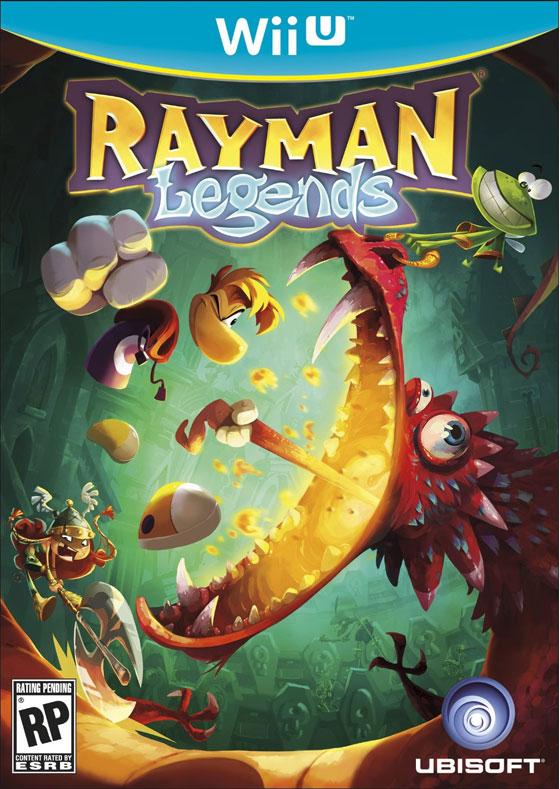With the recent revival of the Rayman video game franchise in 2011 with “Rayman Origins”, a game that took the series back to its roots, it really does bring up the question of how its sequel, “Rayman Legends” seemed to fare. The title began as a Wii U exclusive as well as a Wii U launch title. Ubisoft executives however, delayed development of the game at the last minute in order to port it to other consoles and release all versions at the same time. The game was then released on September 3rd, 2013 for Wii U, PS3, Xbox 360, PS Vita, and PC. This review will be for the Wii U version of the game.
The standard 2D platforming formula of Rayman Origins is still at the core of the gameplay in Legends; except where in the first game you had to work your way up to getting upgraded abilities like gliding, running, or charging up attacks, in Legends you start off with all of these abilities from the very beginning. This helps more than hinders the experience, it simplifies things, and Rayman has always been about simple yet challenging fun. Also, like the first game, playing through it with multiple people is definitely the best part. Legends especially was just built for more than one player, it can be played solo but honestly that just doesn’t do the game proper justice.
What makes it so important to play the game with multiple people is that there are levels centered around the use of the Wii U’s gamepad. These levels have the person who is holding the gamepad use its touch screen to control the character “Murphy” to help the other players navigate the level by solving puzzles for them, moving platforms to them, clearing safe paths, and much more. The Playstation Vita version also has this feature with the Vita’s touch screen, however the other console versions just have what would normally be done on the gamepad done with button commands. In single player these levels are still available but with nobody else as a regular player to walk through the level, a computer controlled player will navigate through the level instead. Without an actual person there to go through the level with you, it really dulls the experience and ruins the feeling of cooperation you get when you have to work together and physically speak to others in order to explain the strategy you might take to overcome a certain obstacle or to be able to get the timing just right.
One thing that separates this game from its predecessor is the new way that boss battles work. Each boss is now rendered in 3D instead of the rest of the game’s hand drawn two-dimensional style, yet it fits perfectly. One complaint would have to be that the bosses were a little easier in this game than in Origins. I felt that the difficulty of the boss battles in Origins was just slightly over the right amount of challenging and just under the right amount of fairness, yet in Legends the bosses were so much easier that they weren’t anywhere near as memorable. Hopefully if there is to be another sequel they find the right balance of difficulty and fairness with the boss battles. Also, following each boss battle in Legends is a music level where the actions of the player are synched up to a song. These levels include popular songs such as “Black Betty” and “Eye of the Tiger”.
The art in the game is simply astounding, and is most likely one of the greatest things about the entire experience. Each level seems to take on a theme and art style of its own, ranging from murky swamps to a colorful Dia De Los Muertos fiesta, or even the dark hulls of a submarine. Each platform, background, enemy or anything at all visually in the game just look s like there was an intense amount of care put into it.
The game features a fairly decent amount of extra content aside from the main levels. There are lucky tickets to collect from getting enough of the collectibles in each level, these give you rewards such as more collectibles or even full levels straight out of Rayman Origins. In fact, Legends contains almost all of the levels from Rayman Origins, making it almost two games in one. One last feature that should be noted is the competitive multiplayer mini-game “Kung Foot”. The mini-game supports up to 4 players; at the start of each game a soccer ball is dropped into the center of the arena, and the goal of the game is to hit the ball into the opposing team’s goal with a timer of 2 minutes set. This mini-game may just be a slight addition to the already large amount of content in the game, but it is incredibly enjoyable in its simplicity.
All-in-all Rayman Legends truly succeeds in comparison to its predecessor and on its own merits is an amazing experience as well. The visuals are as captivating as a moving canvas and the amount of content will keep you entertained for much more than your $60 (or $40 for Vita) worth. I urge anyone with a Wii U to check out this game, it’s both enjoyable for all ages and worth every penny. It should also be noted however, that the Vita version of the game is missing all 28 of the time attack, or “invasion” stages.




